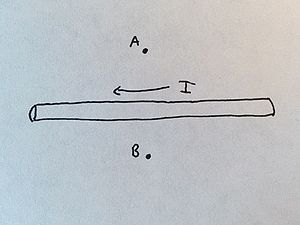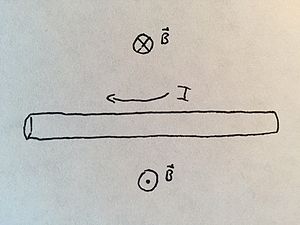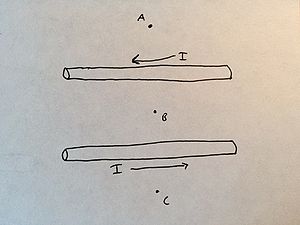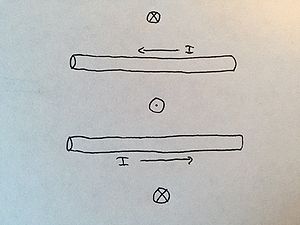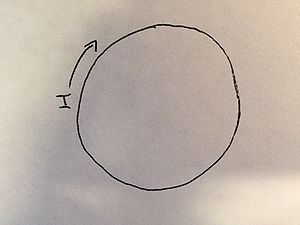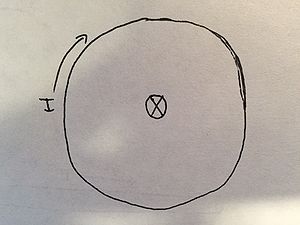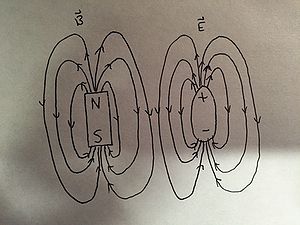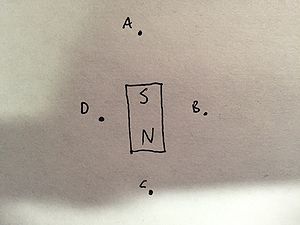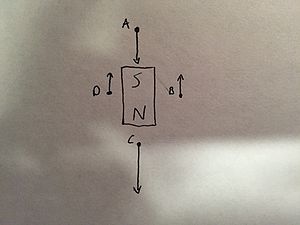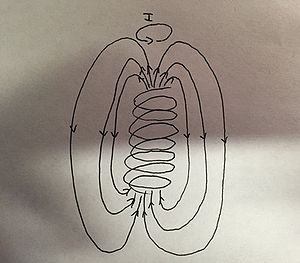Direction of Magnetic Field
This page is here to provide an explanation for finding the direction of magnetic field. Since magnetic field is a cross product, finding its direction can be confusing at times, and you'll be asked many questions involving the direction of the magnetic field due to a moving charge, a current carrying wire, a current carrying coil, a bar magnet, etc. Hopefully this should work as a resource to come to when confused about anything regarding direction of magnetic fields!
The Main Idea
You previously learned about electric fields, and how a charged particle, or group of charged particles create a field in a specific pattern due to those particles' orientations. Magnetic field works in a similar fashion, but remember that it doesn't come from simply a charged particle, but a moving charged particle, with a velocity [math]\displaystyle{ \vec{v} }[/math]. Due to this new concept, we start to see some new patterns that you should want to get very familiar with.
A Mathematical Model
Recall that the equation for magnetic field due to a moving charged particle is [math]\displaystyle{ \vec{B} =\frac{\mu_0}{4\pi} \frac{(q\vec{v} \times \hat{r})}{|\vec{r}|^2} }[/math], otherwise known as the good-ole Biot-Savart law. The most important thing to note about this in regards to direction of magnetic field is that this is a cross product between the charge of the moving particle times its velocity, [math]\displaystyle{ q\vec{v} }[/math] and the unit distance vector from the particle to the observation location, [math]\displaystyle{ \hat{r} }[/math]. This Biot-Savart law is the basis for every orientation of magnetic field you will encounter in this class (wires, magnetic dipoles, etc), and its cross product is what makes finding the direction of magnetic field much trickier than finding the direction of electric field.
A Computational Model
Here is an example of how Vypthon can be used to find the direction of magnetic field for you! Note: you don't actually have to tell Vpython which direction the field should point. If you tell Vpython to take the cross product with the Biot-Savart Law, it will calculate the direction for you. If you plug the following code into Vpython, you can see the visual yourself. This program is based on a moving, negatively charged particle.
from __future__ import division
from visual import *
u=1e-7
qproton=-1.6e-19
scalefactor=2.5e-9
proton = sphere(pos=vector(3e-10,0,0), radius=1e-11, color=color.red)
barrow1=arrow(pos=vector(0,8e-11,0), axis=vector(0,0,0), color=color.cyan)
barrow2=arrow(pos=vector(0,-8e-11,0), axis=vector(0,0,0), color=color.cyan)
barrow3=arrow(pos=vector(0,0,8e-11), axis=vector(0,0,0), color=color.cyan)
barrow4=arrow(pos=vector(0,0,-8e-11), axis=vector(0,0,0), color=color.cyan)
velocity = vector(-5.2e4,0,0)
deltat = 1e-17
scene.autoscale=0
while proton.x<5e-10:
rate(100)
r1 = vector(barrow1.pos-proton.pos)
r1mag = mag(r1)
r1hat = norm(r1)
B1 = (u*qproton*cross(velocity,r1hat))/r1mag**2
r2 = vector(barrow2.pos-proton.pos)
r2mag = mag(r2)
r2hat = norm(r2)
B2 = (u*qproton*cross(velocity,r2hat))/r2mag**2
r3 = vector(barrow3.pos-proton.pos)
r3mag = mag(r3)
r3hat = norm(r3)
B3 = (u*qproton*cross(velocity,r3hat))/r3mag**2
r4 = vector(barrow4.pos-proton.pos)
r4mag = mag(r4)
r4hat = norm(r4)
B4 = (u*qproton*cross(velocity,r4hat))/r4mag**2
barrow1.axis = B1*scalefactor
barrow2.axis = B2*scalefactor
barrow3.axis = B3*scalefactor
barrow4.axis = B4*scalefactor
proton.pos = proton.pos + velocity*deltat
Important Scenarios
A Moving Charged Particle
The first scenario you need to be familiar with is when a particle with a charge [math]\displaystyle{ q }[/math] has a velocity [math]\displaystyle{ v }[/math]. What does this look like? Check out the following image:
Imagine if the red particle was a proton and the green arrow was its velocity. In order to find the direction of the magnetic field created by the moving particle, you need to use the right hand rule, a commonly used tool for physics! The right hand rule appears whenever a cross product is used in a calculation.
Steps for right hand rule:
- Point index finger in direction of first vector in the operation.
- Point middle finger in direction of second vector in the operation.
- Your thumb will naturally point in the direction of the cross product.
Here's a visual for you:
In our case, the cross product is [math]\displaystyle{ q\vec{v} \times \hat{r} }[/math]. So to find the direction of magnetic field for our proton, put your index finger in the direction of [math]\displaystyle{ q\vec{v} }[/math]. Then point your middle finger in the direction of [math]\displaystyle{ \hat{r} }[/math]. Your thumb should now naturally point in the direction of [math]\displaystyle{ \vec{B} }[/math]. Use the right hand rule for our proton, with an observation location above the proton. What do you get?
It should look something like this:

Now what if our proton wasn't a proton, but an electron? We now have a negatively charged particle, causing [math]\displaystyle{ q\vec{v} }[/math] to point in the opposite direction of [math]\displaystyle{ \vec{v} }[/math]. You'll need to adjust your right hand rule accordingly. Remember that you don't point your index finger in the direction of [math]\displaystyle{ \vec{v} }[/math] but in the direction of [math]\displaystyle{ q\vec{v} }[/math]. Using the right hand rule in this fashion, we come up with this:
There's actually a variation of the right hand rule you can use to solve this problem, that some find easier to use. Unlike the electric field, which points in or out radially from a charged particle, magnetic field curls clockwise or counterclockwise around a moving charged particle. To observe this "curling" magnetic field using this variation of the right hand rule:
- Point your thumb in the direction of [math]\displaystyle{ \vec{v} }[/math].
- Your fingers should curl in the direction that the magnetic field curls.
Like this:
You can easily apply this to our proton example. Using this rule, we find that the magnetic field curls in the following fashion:
And there you go! Apply the right hand rule and you can do wonders.
A Current-Carrying Wire
One of the most important situations you'll encounter is the magnetic field created by a current-carrying wire. Luckily, you already have the knowledge to tackle this problem. Conventional current, denoted by the variable [math]\displaystyle{ I }[/math], simply represents the flow of positive charge inside a wire, charges which have a velocity [math]\displaystyle{ \vec{v} }[/math]. Since we're still dealing with the same concept, (magnetic field due to moving charges) we can find the direction of the field produced by a current carrying wire in an almost identical way. Note that while the actual formula for magnetic field due to a short wire is [math]\displaystyle{ \vec{B} =\frac{\mu_0}{4\pi} \frac{I\Delta l \times \hat{r}}{r^2} }[/math], it is derived from the Biot-Savart law, and the cross product is actually saying the same thing, just using [math]\displaystyle{ I }[/math] instead of [math]\displaystyle{ q\vec{v} }[/math]. So how do you think you can find the direction of the magnetic field from this current? You may have already guessed that again, you use the right hand rule. In the case of a current-carrying wire, however, you will almost always want to use the variation of the right hand rule we discussed earlier, in which your thumb points in the direction of [math]\displaystyle{ q\vec{v} }[/math] or in this case [math]\displaystyle{ I }[/math] and your fingers curl in the direction of the magnetic field. Let's look at two examples. One simple, one more difficult.
Example 1
Look at the wire with current flowing in the direction marked [math]\displaystyle{ I }[/math]. What direction does the magnetic field flow at point A? Point B?
Using the right hand rule just once, we can find the solution to both points A and B at the same time. Point your thumb in the direction of [math]\displaystyle{ I }[/math] or in this case, to the left. Your fingers should now curl in such a way that above the wire, your fingers point "into the screen" or "into the page" and below the wire, your finger point in a direction that is "out of the screen" or "out of the page". This is the direction of the magnetic field vector [math]\displaystyle{ \vec{B} }[/math] at these two points. However, since this problem is written up in a two-dimensional space, we need special notation to denote "into the page" and "out of the page". Here's how physicists do it:
Above the wire, to show that [math]\displaystyle{ \vec{B} }[/math] points into the page, we draw an X enclosed by a circle. Imagine if this was an arrow, pointing into the page. The X represents the feathers on the back of the arrow we would see from our perspective. Similarly, for below the wire, where [math]\displaystyle{ \vec{B} }[/math] points out of the page, we draw a dot enclosed by a circle, to signify an arrow pointing out of the page. From our perspective, we see its tip, which looks like a dot.
Now for a more challenging example:
Example 2
Find the direction of magnetic field at points A, B, and C. B is equidistant from both wires. The current in each wire is of the same magnitude.
In this situation, you are presented with two different wires, meaning you have two right hand rules to do. Try it out yourself and see if what you come up with matches the answer:
At point B, both the magnetic field of the top wire and the bottom wire point out of the page and combine, causing the net magnetic field at point B to point out of the page. At point A, the top wire's magnetic field points into the page, and the bottom wire's magnetic field points out of the page. However, magnetic field decreases as distance increases, so the net field at point A points into the page, the direction of the closest wire's field. Point C has the same explanation as point A, with the bottom wire's field greater than the top wire's.
Physics professors and problem makers will try to put wires in different shapes and orientations to confuse you, but just stick to the basics of what you know and you should be able to complete each problem you come across.
A Coil of Wire
There is one special case for a current carrying wire you need to know: a circular coil of wire.
This is just a wire that has been looped around in a circle over and over again, with the amount of times looped called the coil's turns. However, when a current flows through the wire, there is a special right hand rule you can use to find the direction of magnetic field due to the coil. Here's how it's done:
Consider the coil below with an unspecified number of turns. In the center of the coil, what is the direction of the magnetic field due to the current flowing through?
You can actually use the right hand rule for a wire in this problem to solve it. Point your thumb in the direction of the current, and your fingers will curl in the direction of the magnetic field. However there is another variation of the right hand rule you can use to accomplish this that some find easier to use when dealing with current-carrying coils:
- Curl your fingers in the direction of the current (either clockwise or counterclockwise)
- Your thumb will point in the direction of the magnetic field on an axis through the center of the coil.
Your answer should look like this:
Use both right hand rules yourself and discover how both of them lead you to the same answer. Coils will come up more frequently as this class goes on, so make sure you remember how to find the direction of the magnetic field created by them.
Magnetic Dipoles
Remember electric dipoles? Of course you do. Put a positive and negative charge together and you get a really fancy pattern of electric field, where the field comes out of the positive side of the dipole, curls around, and goes back into the negative side. Luckily for you, magnetic dipoles are super easy, because they use the exact same pattern.
Bar Magnet
One of the simplest magnetic dipoles is a bar magnet. A bar magnet is composed of a small "bar" with a north side and a south side. A bar magnet works exactly the same way an electric dipole does in regards to the direction of field created by it. The important concept to remember is that the north "pole" of the bar magnet corresponds to the positive end of the electric dipole, and the south "pole" of the bar magnet corresponds to the negative end of the electric dipole.
Here's a comparison to help you visualize this phenomenon:
Now that you're familiar with the pattern, try an example.
Example
In what direction is the magnetic field at points A, B, C, and D?
Your answer should be based on the dipole pattern you are familiar with:
Notice that similar to an electric dipole, the magnitude of the magnetic field is larger at the ends of the bar magnet than at the sides.
Coils As Magnetic Dipoles
As it turns out, when viewed from a far enough distance, a current-carrying coil shows features of a magnetic dipole. The only difference between the coil and the bar magnet is that the coil doesn't have a predetermined north or south pole. The direction of current determines that instead, meaning you must use the right hand rule to discover which way the field orients.
Here's a final visual to show you what it looks like. Note that current in this coil is flowing counter-clockwise if you look down towards the top of the coil.
Connectedness
- How is this topic connected to something that you are interested in?
- I personally find problems like these kind of fun, that require you to visualize and use things that you know to figure something else out. Also, I've always been interested in the things that go on in our universe that we can't see, so observing the ways that magnetic fields behave is super interesting.
- How is it connected to your major?
- As a mechanical engineer, lots of the same principles used for magnetic fields come up in engineering classes as well. The right hand rule can be used for lots of different physical properties based on cross products, such as moments and torque.
- Is there an interesting industrial application?
- Magnetic field are used in so many products and processes, it would take an extensive amount of time to put together a list. Relevant ones to our lives are our computers we do homework on and our smart phones that we use every day!
History

The 19th century was pretty much the golden age of major discoveries on the basics of magnetic fields. The Biot-Savart Law, which this wiki page is technically based on, was derived after a series of experiments by French scientists Jean-Baptiste Biot and Félix Savart in the year 1820.
See also
Magnetic Field of a Long Straight Wire
External links
Resource for right hand rule
http://physicsed.buffalostate.edu/SeatExpts/resource/rhr/rhr.htm
Encyclopaedia Britannica Entry on Biot-Savart Law
http://www.britannica.com/science/Biot-Savart-law
References
Photo Creds
https://commons.wikimedia.org/wiki/File:Right_hand_rule_cross_product.svg
http://viz.aset.psu.edu/gho/sem_notes/3d_fundamentals/html/3d_coordinates.html
https://en.wikipedia.org/wiki/Jean-Baptiste_Biot
Author
Page initiated by Devon Long--Dlong42 (talk) 23 October 2015





